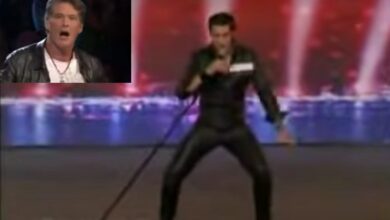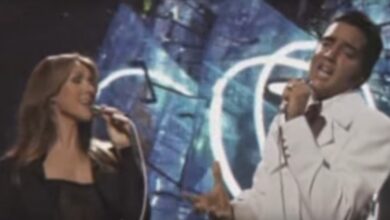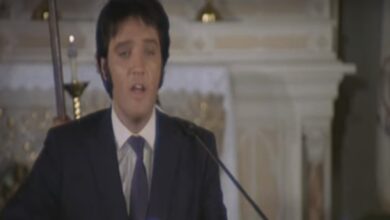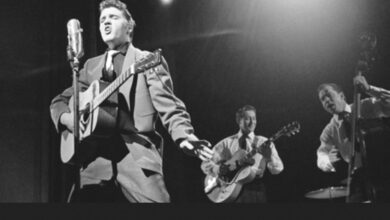Forty-Two Years On, The Magic Persists; His Impeccable Performance Still Astounds
“You Don’t Have to Say You Love Me,” a song that has traversed decades and generations, is characterized by its strikingly relatable themes of love, heartache, and emotional vulnerability. Originally released by Dusty Springfield in 1966, the song quickly became a hallmark of her powerful vocal style and the emotive storytelling that defined her work. The collaboration of Italian songwriters Pino Donaggio and Vito Pallavicini, combined with the English lyrics crafted by Simon Napier-Bell and Vicki Wickham, created a poignant narrative that resonated deeply with listeners, particularly during the turbulent 1960s. Dusty’s signature contralto voice, combined with the lush orchestration of the original recording, captivated audiences and solidified the song’s place in the pantheon of classic pop and soul ballads.
Dusty Springfield, born Mary Isobel Catherine Bernadette O’Brien in 1939 in London, is often heralded as one of the greatest female singers of her era. Her unique blend of pop and soul drew from a variety of influences, including Motown and the girl groups of the day, allowing her to carve out a distinct niche in the music industry. Her emotional depth and ability to convey vulnerability in her performances made her a beloved figure, and her rendition of “You Don’t Have to Say You Love Me” showcased these qualities perfectly. This particular track exemplified the dynamics of unrequited love, where the protagonist acknowledges the complexities of their feelings, thus inviting listeners to empathize with her emotional turmoil.
Elvis Presley’s live version of “You Don’t Have to Say You Love Me,” performed in 1970, serves as an intriguing contrast to Dusty Springfield’s. Presley’s approach infused the song with a more raw and intimate energy, reflecting his unique artistic sensibilities. Capturing the essence of the lyrics, Elvis’s rendition peeled back the layers of orchestration that characterized the original, allowing his smooth vocal delivery to take center stage. The stripped-down arrangement further enhanced the emotional weight of the song, creating a moment of connection with his audience that felt deeply personal and relatable.
Born on January 8, 1935, in Tupelo, Mississippi, Elvis Aaron Presley rapidly became a cultural phenomenon, often referred to as the “King of Rock and Roll.” His ascent to fame began with the release of songs that blended various genres, including rhythm and blues, country, and gospel. This eclectic mix not only showcased his vocal versatility but also indicated his ability to transcend musical boundaries. Throughout the 1950s and into the subsequent decades, Elvis’s energetic performances and charismatic persona helped to shape popular music as we know it today.
Elvis’s 1970s live performances demonstrated his ongoing evolution as an artist. During this period, he engaged in extensive tours and even took up a residency in Las Vegas, where he delivered electrifying shows that garnered a dedicated following. His interpretations of ballads like “You Don’t Have to Say You Love Me” during these performances offered a glimpse into his emotive abilities—one that could transform and breathe new life into existing works. Known for his emotional engagement with the music, Elvis often made songs feel immediate and real, resonating with audiences on many layers.
The live performance of “You Don’t Have to Say You Love Me” showcased not just his vocal power, but also his capacity for storytelling—a trait that brought his songs to life. By infusing personal connections and experiences into his music, he transported listeners into the narrative of heartache and yearning that the lyrics depicted. This personal touch is part of what has kept Elvis’s music relevant, as listeners continue to connect with those universal themes of love, loss, and longing.
Elvis’s impact extended far beyond music; his influence permeated popular culture, inspiring countless artists across genres. His unique style and approach to performance set new standards, serving as a blueprint for future musicians. The emotional authenticity he brought to every song contributed significantly to his legendary status, and tracks like “You Don’t Have to Say You Love Me” exemplify that connection. His ability to cover songs while simultaneously making them distinctly his own is a hallmark of his career.
In reflecting on the legacy of both Dusty Springfield and Elvis Presley, it is clear that “You Don’t Have to Say You Love Me” serves as a vivid reminder of their artistry. Dusty’s original evokes the ache of desiring love and recognition, while Elvis’s reinterpretation highlights the enduring pain of heartache through a raw and stripped-down lens. The song’s essence has allowed it to be reimagined and celebrated across generations, reinforcing its significance in the landscape of popular music.
The song has since inspired multiple covers and renditions, yet the emotional core remains intact thanks to the original performances by both Springfield and Presley. Each artist brought their own life experiences and artistic vision to the table, enriching the song’s legacy and sparking its enduring popularity. As music continues to evolve, “You Don’t Have to Say You Love Me” remains a powerful anthem that resonates with those confronting the complexities of love relationships.
Ultimately, the enduring appeal of “You Don’t Have to Say You Love Me” lies in its universal themes and the incredible vocal talents of artists like Dusty Springfield and Elvis Presley. As they navigated the landscape of their careers, each added depth and dimension to the song, turning it into a timeless classic that continues to resonate with those navigating their own journeys of love and longing. Their legacies serve as testaments to the power of music to convey profound emotional truths, ensuring that this song will live on in the hearts of listeners for years to come.



